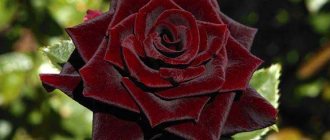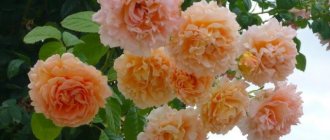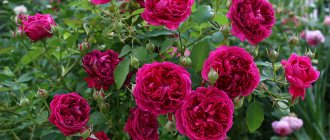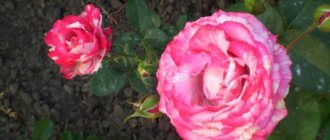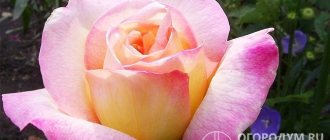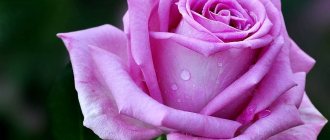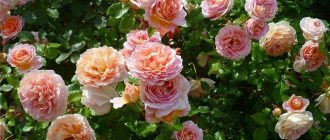In recent decades, breeders have developed many new varieties of the “queen of flowers” with improved characteristics and belonging to different types of this shrub: hybrid tea, floribunda, climbing and others.
When developing a new variety from the floribunda series of roses, breeders managed to develop the “queen of flowers” with long-lasting abundant flowering, improved resistance to frost and most diseases characteristic of many varieties of roses - a rose called the “ Brothers Grimm ”.
History of variety development
Rose Brothers Grimm floribunda
This variety of floribunda rose was bred by German breeders at the beginning of this century, and it was presented to the public in the famous series of these specialists, called “Fairytale Roses”. The German name for this stem is gebruder grimm rouse, which translated means “rose of the Brothers Grimm.”
Related article:
Rose Jubilee Prince of Monaco
This perennial has captivated flower growers from around the world with the attractiveness and tenderness of its blooming buds, repeated flowering and a pleasant, unobtrusive aroma.
The variety is highly resistant to frost and other changes in climatic conditions. However, in the southern regions, in the heat, it is necessary to regularly water the bush, since a lack of moisture leads to a deterioration in the color of the buds.
Origin of the variety
The rose "Gebruder Grimm" was created by breeders of the famous German nursery Kordes. The variety was bred in 2002, registered as KORassenet, certified under the ADR system and included in the collection “Fairytale Roses” (Marchen-Rosen). In subsequent years, Gebruder Grimm repeatedly won prestigious international awards: the BUGA gold medal in Potsdam, silver in Kortrijk, bronze in Rome, RNRS certificate of honor and others. In different countries it is also known under the names: Brothers Grimm, Gremlin, Joli Tambour, Eternal Flame and Fairy Tale.
It’s not for nothing that the variety is classified as part of the “Fairytale Roses” series - the flowers have an amazing “magical” beauty
Description and characteristics of the variety
The Brothers Grimm rose bushes are of medium height, quite compact, and their lateral stems grow well. The diameter of the shrub is up to 0.5 m. The shoots are erect, well leafy, and can reach 0.9 m in height. The foliage is large, with sharp tips, shiny, smooth, dark emerald color.
During the flowering period, bushes require tying to supports, and supports should be placed under the flower stalks so that they do not break off under the weight of the blooming buds.
The Brothers Grimm rose blooms for a long time, throughout the entire season with short breaks.
Related article:
The main reasons for the death of young roses
The outer petals of the blooming buds are rich orange, and the middle ones are sandy yellow. As the flowers bloom, they change their color to crimson-pink. The shape of the buds is goblet.
The buds are densely double, each flower has up to 45 petals. The diameter of a blooming flower is up to 11 cm. Up to 3-5 buds can bloom on one peduncle.
The variety is highly resistant to frost and sudden temperature fluctuations, as well as to a number of diseases characteristic of other “queen of flowers” varieties, and to pest attacks.
The buds are not afraid of heavy rains, they do not lose their shape, and the petals do not become stained. And in the heat, flower petals do not fade and do not bake under the hot rays of the sun.
Description of the plant
A vigorously growing, voluminous, branched bush reaches 80-100 cm in height and 50-60 cm in width. In a favorable climate and with proper care, dimensions can significantly exceed average parameters. The shoots are vertical, prone to branching, relatively strong, densely leafy, with a small number of thorns. The foliage is large, expressive, rich dark green in color with a strong glossy sheen.
The shoots are prone to branching and if they are not strengthened and tied to supports, especially during periods of abundant flowering, the branches can simply creep along the ground
Features of flowering
The shrub blooms profusely and luxuriantly in several waves throughout the season, from June until the first autumn frosts. The buds are round and dense. The flowers are densely double, lush, nostalgic in shape (rosette-shaped), appear singly or in clusters of 3-7 pieces. They consist of 35-40 velvety petals with a wavy edge; when fully bloomed, they have a diameter of 8-10 cm (up to 12 cm).
Flowers at different stages of bloom have completely different shades, which gives the bush additional charm
The blooming buds first delight the eye with the luminous, coral-orange color of the petals with a sandy-yellow reverse, and then acquire a raspberry-pink color. During flowering, the rose delights not only with its beauty, but also with its delicate, subtle floral aroma.
Bright lush flowers do not last long after cutting, but fit “fabulously” into various floral compositions
Advantages of the variety
The main advantages of the Brothers Grimm rose variety include:
- abundant re-blooming;
- beautiful bud shape;
- flowers are large, double, with a beautiful bright color that changes as the flowers bloom;
- the variety is resistant to frost and hot periods;
- flowers do not fade in the sun and do not lose shape during rains;
- pleasant subtle aroma of blossoming buds.
Related article:
The best varieties of floribunda roses
Flower propagation
Floribunda roses are propagated by cuttings or grafted onto rootstocks. Mainly propagated by cuttings.
When to produce
The Brothers Grimm rose is propagated in autumn and spring. It is preferable to propagate in the fall, as the plants tolerate frost better.
Detailed description
Cuttings are cut from woody shoots. They should be about 8 cm, the cut location is determined to be 0.5 cm above the bud. The lower cut is 45 degrees, and the upper one is made at a right angle. Thorns and leaves are removed from the bottom of the cutting. Can be treated with a growth stimulator. Rooting can be done in open ground.
Cuttings
Use in landscape design
The Brothers Grimm rose variety is actively used in landscape design - it is planted in single plantings, as well as together with other annual and perennial flowers in city parks and squares, as well as in summer cottages.
It should be noted that these roses go well with the following flowers and plants:
- phlox;
- cereal crops;
- delphinium;
- clematis.
Use Cases
The Brothers Grimm variety is suitable for placement in single and group plantings. In the first case, it will look great against the backdrop of a bright grass lawn or evergreen needles located behind the bush. The flower can be combined on the site with white, pale yellow, soft pink and cream roses. Combinations of European beauty with clematis, phlox, delphiniums, cereals, and fragrant flowering herbs are successful. The variety is often used to decorate low garden hedges and borders.
Growing
Growing the Brothers Grimm rose variety is not too difficult; the technology for planting seedlings and further care are approximately the same for all varieties of roses. But there are certain nuances that need to be taken into account when planting plants, as well as when further growing rose bushes Brothers Grimm
Related article:
Pruning roses in spring: rules, tips, recommendations
A rose of this variety will grow in one place for more than one season, and in order for it to feel comfortable, you need to choose the right place for planting, fertilize the area and plant seedlings.
Time for planting the variety
The Brothers Grimm rose variety can be planted both in spring and autumn. In spring, seedlings of this shrub can be planted from the last ten days of April to the last ten days of May. In this case, planting is carried out before the buds on the shoots of the bushes begin to swell.
In autumn, the time for planting this flower is from early September to mid-October. The main thing is that at least a month remains from the time of planting until the onset of frost.
Selecting a site for planting
Rose bushes feel comfortable in areas well lit by sunlight. The Brothers Grimm rose should not be planted even in partial shade - there its petals may be less bright. Also, you cannot grow this flower in lowlands or other places where moisture often stagnates - in such cases, the root system of this perennial can be affected by root rot.
Related article:
Roses from autumn cuttings
Although rose bushes should be ventilated with a light breeze. However, they should be protected from strong drafts and gusts of cold wind. But before planting seedlings, you need to prepare the area - clear it of weeds and other vegetation residues, add humus or compost, as well as potassium-phosphorus fertilizers for digging. All these feedings are necessary so that the Brothers Grimm rose seedlings actively begin to grow and subsequently bloom profusely.
Important ! Loose and fertile soil should have a slightly acidic reaction.
You should carefully select seedlings of this variety for planting - they should have three mature seedlings with green, smooth bark. The roots of the plant should also be strong and healthy, without visible damage. The root collar of seedlings should be about 8 mm in diameter.
Before planting, all dry parts of the roots and stems are cut off, and healthy shoots should be shortened slightly, leaving at least 3 healthy buds on each. The root system is also shortened to 25-30 cm.
Related article:
How to propagate garden roses
Step-by-step landing instructions
In the prepared area, planting holes should be dug up to 0.6 m deep. The diameter of the holes should be slightly larger than the size of the root system.
A layer of drainage material is laid on the bottom - small crushed stone or pebbles. The next layer is organic fertilizer, and on top is a layer of garden soil. Then the seedling is placed vertically and the roots are carefully straightened. Then the holes are filled with the remaining substrate, compacted and watered. At least 3-4 liters of water are poured under each seedling.
The root zone can be covered with a layer of mulch on top so that moisture evaporates more slowly and weeds do not sprout.
Diseases
Does the rose have a gray-white coating or brown balls on the leaves? Methods to combat the disease.
Powdery mildew
Black spots of a round shape have appeared on the leaves of the rose, what should I do, how can I save the plant?
Black spot
The rose is sprinkled with yellow powder, the leaves and stems crack and die, how to get rid of the disease?
Rust
Has a gray coating appeared on the rose? This is gray rot that needs to be gotten rid of as soon as possible.
Gray rot
The soil for planting roses must first be cleared of weeds. It is advisable to choose soil with a low pH reading. A hole 60 cm deep and wide is prepared for the seedling. Drainage is formed from fine gravel or crushed stone at the bottom.
The next layer should be humus, manure or compost. Before planting, it is necessary to treat the root system of the seedling, trimming diseased and affected roots. The buds sink 3 cm into the ground. It is unacceptable to plant a rose at a distance of less than 60 cm from other plants.
Watering is done once a week immediately when the top layer of soil dries. The soil needs to be loosened regularly so that the roots are saturated with oxygen and the number of weeds is reduced.
In the spring it is recommended to feed the shrub with a nitrogen complex, in the summer during the period of active flowering - with fertilizers based on phosphorus and potassium. Mulching is done using sawdust or peat.
Sanitary pruning should be carried out in the spring. All damaged and dry shoots are removed from the bush. The plant will become stronger when it is freed from excess branches. You should not remove too many shoots, as this may cause the plant’s shoots to become elongated, and flowering will occur too late - in late summer or early September.
Before wintering, you need to pick off all the dry leaves and buds from the crop, shorten the bush, sprinkle it with dry soil and cover it with spruce branches until the end of frost.
Further care
The development of planted rose seedlings directly depends on the care that gardeners provide them. The most important thing during this period will be compliance with the irrigation regime, application of fertilizers and pruning of shoots.
Related article:
How to simply cover roses and peonies
Watering and humidity
The Brothers Grimm rose does not tolerate periods of drought well - it begins to drop buds and blossoming flowers, and will not form new ones. Therefore, watering should be regular and quite abundant. Water for irrigation should be warm and filtered. The bushes should be watered either early in the morning or in the evening.
In the hot summer in the evening hours, it is recommended to spray the foliage of the bushes with warm water from a spray bottle, then the vegetative mass of rose bushes will look fresher.
After watering, it is necessary to loosen the root zone, simultaneously removing all weeds.
Feeding
In order for the flowering of roses of this variety to be abundant and constant, fertilizing should be applied to their trunk circles throughout the summer season. Usually, the application of organic matter (rotted manure or humus) with complex mineral fertilizers (urea, potassium salts) alternates.
Important ! You should not overuse nitrogen fertilizers under the rose. They are usually applied in early spring to stimulate the growth of vegetative mass. If nitrogen is added throughout the season, the rose bushes will actively increase green mass to the detriment of the development of buds.
Trimming
To ensure abundant flowering, rose bushes should be pruned regularly, removing old shoots and damaged or dried branches.
Related article:
Border roses: 5 most beautiful varieties
The main sanitary pruning is carried out in early spring before the start of sap flow in the shoots. In this case, all old, dried, frozen or damaged shoots are removed.
Pruning roses
During the summer, drying flowers are removed so that new buds begin to form. Pruning during this period is carried out only if necessary.
In the autumn, in the process of preparing the bush for the winter, the old branches are completely cut out, the shoots are shortened by 4-5 eyes. All side shoots on the main stems must also be shortened.
Features of growing roses in open ground
Rose High Magic - what is this hybrid variety, description
In order for the plant to develop and bloom well, it is necessary to plant it correctly. In a particular case, planting is mainly carried out with seedlings.
Note! Reproduction of roses by seeds is possible, but the process takes a lot of time and effort, and does not guarantee a favorable outcome.
The right time for planting seedlings is April 20-May 30. In autumn, this period ranges between September 10 and October 20. It is recommended to plant the plant in a sunny place. The culture is not placed in lowlands because it loves light and warmth. The area must be protected from drafts.
Appearance of healthy rose cuttings
The soil should be fertile, loose and slightly acidic. Shortly before planting, the area should be dug up and weeds should be removed.
Algorithm for planting a seedling:
- In the selected area, holes measuring 60x45 cm are dug.
- A drainage layer is laid at the bottom using expanded clay or broken bricks, followed by organic fertilizers.
- A nutritious soil mixture is poured over the drainage and layer of fertilizer.
- The seedling is lowered into the hole and covered with soil, which is compacted a little at the end.
The plant must be watered, after which the circle around the trunk is mulched with sawdust or rotted humus.
Important ! Fertile buds should be below 3 cm from ground level.
Rose planted in the ground
Preparing for winter
In most Russian regions with harsh winter seasons, the Brothers Grimm rose should be covered before frost, despite its high resistance to frost.
First, the bushes are pruned, then the bushes are hilled, raking the soil to the base of the plant. The thickness of the soil layer should be at least 10-12 cm - this way the root system of rose bushes is protected from freezing.
Related article:
3 main steps for caring for roses in summer
Sheltering roses for the winter
Then the bushes are covered with a layer of foliage, and a non-woven fabric is stretched on top. At the beginning of spring, the cover is removed so that the bushes do not begin to rot.
There is an excellent article on our website about how you can insulate a rose for the winter.
Features of the variety, why it is attractive
The attractiveness of the Gebruder Grimm variety is due not only to the amazing beauty of the shrub, but also to its varietal characteristics.
| Average cold resistance | The bush tolerates winter temperature drops well, but it is recommended to cover it for the winter. In addition, when choosing a landing site, it is recommended to select an area where cold air does not stagnate. |
| Heat resistance | Tolerates sudden increases in temperature, although the lack of additional moisture can negatively affect the abundance of flowering |
| Resistance to diseases and pest attacks | It is noteworthy that even aphids, which often annoy gardeners, cannot greatly harm the flower. The latter is due to the fact that rose buds quickly harden and parasites cannot damage them. |
The Brothers Grimm variety will delight any gardener with its high level of resistance to heat, cold and disease.
It is traditionally believed that roses are very capricious plants that a novice gardener cannot grow, but this variety refutes such an idea.
We invite you to watch a video about a wonderful plant:
Diseases and pests
The Brothers Grimm rose variety is resistant to most diseases that are characteristic of other “queens of flowers.” In particular, it has high resistance to powdery mildew and black spot.
Among insect pests, this variety can infect aphids or spider mites. Usually they fight these insects with folk remedies - wash them off with soapy water or spray the bushes with garlic broth. If the pest colony is large, then special insecticidal preparations have to be used.
Diseases, pests and ways to combat them
For this variety of roses, aphids are dangerous, as they feed on the sap of the plant and weaken its growth. It also carries other diseases that are dangerous to roses. Fungal diseases include powdery mildew, which thrives in confined spaces. To do this, the bush is thinned out and watered only at the root. A universal remedy is copper sulfate. It is diluted in a weak solution and sprayed on the plant in the spring. To combat mold, the drug Funkginex is used. A solution of slaked soda perfectly fights black spotting.
Pests and diseases
Rose Gebrüder Grimm blooms beautifully and delights gardeners with its abundant buds. Compared to other varieties, it has its advantages and very few disadvantages.
Reviews from those who planted
Olga, 45 years old, Penza region
I bought the Brothers Grimm rose for the occasion at a nursery. I purchased several seedlings because I was afraid that some of them might freeze. But the bushes all began to grow, quickly began to grow, and already in the second year after planting they began to bloom. I would like to note that this rose variety does not tolerate periods of drought, so they need to be watered constantly. I especially want to note the beauty of the blooming buds, which change their color as they open.
Natalya, 55 years old, Samara
On my plot I grow different varieties of roses, including the Brothers Grimm. These roses are distinguished by the bright color of their buds, voluminous lush bushes with a lot of greenery. Therefore, the Brothers Grimm variety stands out among other flowers in flower beds, and it can also be used in single plantings.
It should be noted that the Brothers Grimm rose bushes are distinguished by the lushness of the bushes and abundant constant flowering throughout the season. Their beautiful double flowers with a delicate delicate aroma stand out among other flowers in flower beds. Therefore, this German variety of the “queen of flowers” has become popular with many flower growers from around the world.
Reviews from gardeners
Olga, 44 years old, Taganrog
My rose is 5 years old. Significantly exceeds the average parameters - it produces lashes 2 m long, I cut the hair mercilessly! I transplanted it to the climbers, apparently in the south it is better to grow the variety as a semi-climbing variety. I tie it to the supports. My health is excellent. On one shoot there are both yellow-orange and crimson-scarlet flowers. The shade changes as it blooms and depending on the weather.
Tatyana, 46 years old, Omsk
My bush is growing like crazy after the second winter! Branches 1.5 m long fall from the supports. Grows in full sun, blooms profusely, healthy foliage. True, if you don’t do regular pruning, the bush grows awkwardly, branches in different unexpected directions.
Marina 38 years old, Belgorod
I have 2 bushes: one in full sun, the second in partial shade. They develop equally and do not suffer from any diseases. They begin to bloom at the same time, they tolerate sun and showers well. The flower is very beautiful, but does not last long, only a couple of days and falls off. Bright shades quickly fade to dull pale pink.
The most popular varieties of roses. Part 1. Floribunda. Hybrid tea roses. Grandiflora
Roses are most people's favorite flowers. A bouquet of roses is a universal gift for any occasion. A rose bush is a decoration for the garden and the envy of the neighbors. Roses are hybrid, winter-hardy, bush, red, white, pink. Let's try to study in order the best varieties of roses, names of varieties, descriptions, their history, as well as the average price. In addition, roses, in addition to the variety, are divided into types.
Variety: Floribunda
Floribunda roses are considered an intermediate variety between hybrid tea and climbing varieties of roses. They were developed in Denmark in 1924. But first they treated tea roses. It became a separate variety only in 1976.
Translated from Latin, “floribunda” means “blooming abundantly.” These roses are bush roses, bloom almost all summer, and are quite resistant to cold. The buds are usually large, consisting of an abundance of medium-double petals.
Suitable for small bouquets and flower arrangements.
Subsequently, breeders developed many types of floribunda - large buds of bright, varied colors.
Types of floribunda roses:
Golden Wedding (Golden Wedding)
History: This type of rose was bred in Great Britain in 1992.
Description: Bush about 90 cm high. Bud diameter – 6-8 cm. Yellow flowers, similar to a water lily. The aroma is light.
Photo 1. Rose Golden Wedding
Samba
History: This type of rose was developed in Germany in 1964.
Description: Bush about 90 cm high. Bud diameter is 8 cm. Flowers are yellow-orange with scarlet edges. The aroma is weak.
Photo 2. Rose Samba
La Paloma
History: This type of rose was developed in Germany in 1985.
Description: Bush about 60 cm high. Bud diameter is 7-8 cm. The flowers are creamy white. The aroma is weak.
Photo 3. Rose of La Paloma
Lyon
History: This type of rose was bred in Germany in 2002.
Description: Bush about 60 cm high. Bud diameter is 7-8 cm. The flowers are creamy pink. The aroma is weak.
Photo 4. Rose Lyon
Leonardo Da Vinci
History: This type of rose was developed in France in 1993.
Description: Bush is approximately 1 m high. Bud diameter is 10 cm. The flowers are deep pink, double. The aroma is light.
Photo 5. Rose by Leonardo Da Vinci
Chaikovsky
History: This type of rose was developed in France in 2000.
Description: Bush about 80 cm high. Bud diameter – 9 cm. Creamy, double flowers. The aroma is strong.
Photo 6. Rose Tchaikovsky
Brothers Grimm
History: This type of rose was bred in Germany in 2002.
Description: Bush about 90 cm high. Bud diameter is 8-11 cm. Flowers are orange-red, double. The aroma is weak.
Photo 7. Rose Brothers Grimm
Pomponella
History: This type of rose was bred in Germany in 2005.
Description: The bush is about 80 cm high. The diameter of the bud is 5 cm. The flowers are pink, reminiscent of peonies. The aroma is light.
Photo 8. Rose Pomponella
Jubilee of the Prince of Monaco
History: This type of rose was developed in France in 2000.
Description: Bush about 80 cm high. Bud diameter is 10 cm. The flowers are white with a crimson border. The aroma is weak.
Photo 9. Rose Jubilee of the Prince of Monaco
Concerto
History: This type of rose was developed in France in 1994.
Description: Bush about 1 m high. Bud diameter – 9 cm. Flowers are pink-peach, double. The aroma is weak.
Photo 10. Rose Concerto
Purple Tiger (Purple Tiger)
History: The rose species was developed in the USA in 1991.
Description: Bush about 1 m high. Bud diameter – 9 cm. Flowers are striped, purple-pink with white veins. The aroma is weak. The advantage is a small number of thorns.
Photo 11. Rose Purple Tiger
Variety: Hybrid tea roses
Hybrid tea roses appeared in France in 1867, thanks to long crossing of a large number of varieties. Although they became a separate group of varieties not so long ago - in 1997. This type of roses has an erect appearance, i.e. bouquets of such flowers can be high - about 1 meter. They bloom in stages - some flowers are replaced by others from June to October.
The color range of hybrid tea roses varies from delicate pastel shades to bright reds and pinks. Rose petals are large, buds are round or standard cone-shaped.
Also, hybrid tea roses differ from other varieties in their unique aroma, actually reminiscent of black tea.
Types of hybrid tea roses:
Double Delight (Double pleasure)
History: This type of rose was developed in the USA in 1977.
Description: Bush about 150 cm high. Bud diameter – 14 cm. Cream flowers with a wide scarlet border. The aroma is strong, fruity.
Photo 12. Rose Double Delight
Gloria Day
History: This type of rose was developed in France in 1945.
Description: Bush about 150 cm high. Bud diameter – 15 cm. Yellow flowers with a soft pink border. The aroma is medium, sweet.
https://www.youtube.com/watch?v=Vbr8KvGRIb4
Photo 13. Rose Gloria Day
Paradise
History: This type of rose was developed in the USA in 1978.
Description: Bush about 120 cm high. Bud diameter – 10 cm. Lilac flowers with a dark border. The aroma is strong.
Photo 14. Rose Paradise
Nicole
History: This type of rose was developed in Germany in 1998.
Description: Bush about 110 cm high. One stem has one flower. The diameter of the bud is 8-10 cm. The flowers are red with a white back side. The aroma is weak.
Photo 15. Rose Nicole
Cherry Brandy (Cherry Brandy)
History: This type of rose was developed in Germany in 2004.
Description: The bush is about 90 cm high. The diameter of the bud is 8-10 cm. The flowers are pink on the outside, orange on the inside. The aroma is light, fruity.
Photo 16 Rose Cherry Brandy
Alpin Sunset (Alpine Sunset)
History: This type of rose was developed in Great Britain in 1973.
Description: Bush about 1 m high. Bud diameter is 15 cm. Flowers are apricot in color with a pink undertone. The aroma is strong.
Photo 17. Rose Alpine Sunset
Eiffel Tower (Eiffel Tower)
History: This type of rose was developed in the USA in 1963.
Description: Bush about 150 cm high. Bud diameter – 12 cm. Flowers lilac-pink. The aroma is strong.
Photo 18. Rose Eiffel Tower
Virginia
History: This type of rose was developed in France in 1994.
Description: Bush about 90 cm high. Bud diameter is 8-10 cm. The flowers are white with a cream undertone, double. The aroma is light. The spines are small.
Photo 19. Rose Virginia
Sphinx Gold (Golden Sphinx)
History: This type of rose was developed in the Netherlands in 1997.
Description: Bush about 120 cm high. Bud diameter – 8 cm. Flowers are bright yellow, flattened, petals with wavy edges. The aroma is light.
Photo 20. Rose Sphinx Gold
Cool Water (Cold Water)
History: This type of rose was developed in the Netherlands.
Description: Bush about 1 m high. Bud diameter is 6-8 cm. The flowers are lilac, cool in color. The aroma is light.
Photo 21. Rose Cool Water
Bella Pearl (Beautiful Pearl)
History: This type of rose was developed in France in 1997.
Description: Bush about 130 cm high. Bud diameter – 10 cm. Cream flowers with pink washes. The aroma is light.
Photo 22. Rose Bella Pearl
Ambias
History: This type of rose was developed in France in 1998.
Description: Bush about 1 m high. Bud diameter is 8-10 cm. The flowers are yellow with an orange border. The aroma is light.
Photo 23. Rose Ambias
Goldshen Pearl (Golden Pearl)
History: This type of rose was developed in Germany in 1987.
Description: Bush about 90 cm high. Bud diameter is 8-10 cm. Flowers are coral-red, double. The aroma is light.
Photo 24. Rose Goldshen Pearl
Anastasia
History: This type of rose was developed in France in 2001.
Description: The bush is about 110 cm high. The diameter of the bud is 10-12 cm. The flowers are white with a creamy core. The aroma is light.
Photo 25. Rosa Anastasia
Papillon (Butterfly)
History: This type of rose was developed in Germany in 1997.
Description: The bush is about 85 cm high. The diameter of the bud is 11 cm. The flowers are lemon-yellow, the petals have grooved edges. The aroma is light.
Photo 26. Rose Papillon
Sultan
History: This type of rose was developed in France in 1946.
Description: Bush about 120 cm high. Bud diameter is 10 cm. The flowers are scarlet, the reverse side is yellow. The aroma is light.
Photo 27. Rosa Sultan
Landora
History: This type of rose was developed in Germany in 1970.
Description: Bush about 125 cm high. Bud diameter is 12 cm. The flowers are bright yellow. The aroma is light. One of the most popular species in Europe.
Photo 28. Rose of Landora
Lankoma
History: This type of rose was developed in France in 1973.
Description: Bush about 1 m high. Bud diameter is 10 cm. The flowers are deep pink. The aroma is weak.
Photo 29. Rose Lancoma
Flamingo
History: This type of rose was developed in Germany in 1979.
Description: Bush about 125 cm high. Bud diameter is 10 cm. The flowers are pale pink. The aroma is weak. The spikes are large.
Photo 30. Rose Flamingo
Ville de Villeurbanne
History: This type of rose was developed in France in 1987.
Description: Bush about 120 cm high. Bud diameter is 11 cm. The flowers are deep pink with a beige base. The aroma is light.
Photo 31. Rose Ville de Villeurbanne
Corvette
History: This type of rose was developed in Germany in 1997.
Description: Bush about 185 cm high. Bud diameter – 10-12 cm. Flowers are orange-red, glossy. The aroma is weak.
Photo 32. Rose Corvette
Wine Rosso
History: This type of rose was developed in Germany in 2007.
Description: Bush about 140 cm high. Bud diameter is 7-9 cm. The flowers are burgundy, wine-colored. The aroma is light.
Photo 33. Rose Vino Rosso
Blue Moon (Blue Moon)
History: This type of rose was developed in Germany in 1964.
Description: The bush is about 1 m high. The diameter of the bud is 10-12 cm. The flowers are lilac, turning blue in bright sun. The aroma is light, with spicy notes.
Photo 34. Rose Blue Moon
Variety: Grandiflora
Some roses are purely English varieties. Grandiflora was created in 1954 by crossing floribunda and hybrid tea rose. Until now, in many countries it is not recognized as a full-fledged variety, including in England itself.
In appearance, grandiflora is more similar to hybrid tea varieties. The stems are long and strong. The flowers are often double or semi-double. Translated, “grandiflora” means “large flower.” The rose is resistant to frost and disease.
Has a wonderful aroma.
Grandiflora looks great in prefabricated bouquets and various compositions.
Types of rose grandiflora:
Queen Elizabeth (Queen Elizabeth)
History: This type of rose was developed in the USA in 1954.
Description: Bush about 250 cm high. Bud diameter is 10-11 cm. The flowers are soft pink, the petals are wavy. The aroma is delicate. The rose is named in honor of the English Queen Elizabeth II.
Photo 35. Rose Queen Elizabeth
Montezuma
History: This type of rose was developed in the USA in 1955.
Description: Bush about 90 cm high. Bud diameter is 10 cm. Flowers are orange-red, double. The aroma is light.
Photo 36. Rose Montezuma
Mount Shasta
History: This type of rose was developed in the USA in 1963.
Description: Bush about 120 cm high. Bud diameter is 12 cm. The flowers are white with a soft pink undertone. The aroma is light. Rose is ideal for wedding bouquets.
Photo 37. Rose Mount Shasta
Marcel Pagnol
History: This type of rose was developed in France in 1994.
Description: Bush about 125 cm high. Bud diameter – 12 cm. Red flowers. The aroma is strong and sweet.
https://www.youtube.com/watch?v=Vbr8KvGRIb4
Photo 38. Rose Marcel Pagnol
Read more about other varieties (ground cover roses, climbing roses and Austin roses) in the next article.
Source: https://zen.yandex.ru/media/id/5c8cf38a72d81e00b3a333eb/samye-populiarnye-sorta-roz-chast-1-floribunda-chainogibridnye-rozy-grandiflora-5e3a7545caef2f216217f3cf
Brief description of the Brothers Grimm rose (Gebruder Grimm)
Rose Gebrüder Grimm blooms twice during one growing season. It is worth noting that the first flowering is always more lush and spectacular. The buds are formed in a rich pink-orange color, the structure of the petals is densely double.
If you look at the flowers some time after they open, the petals will already have a raspberry-pink hue. The leaves are medium in size, have a rich green color, and have a glossy surface. An average of 3 to 7 buds are formed on each shoot.
During flowering they emit a pleasant, mild aroma.
Appearance of the floribunda rose Brothers Grimm
Note! The plant grows quite rapidly on any type of soil. The variety has excellent frost and drought resistance and is not afraid of precipitation.
Plant care
The plant is unpretentious, but needs to follow the basic rules of cultivation, which boil down to regular watering, fertilizing, mulching, pruning and preventing the development of diseases.
In the spring, soon after awakening, sanitary pruning is carried out, during which damaged shoots are removed. Next, nitrogen-containing fertilizers are applied to actively increase green mass. Closer to autumn, it is more advisable to use combined mineral compositions.
Despite the good indicators of resistance to diseases, it is imperative to spray the bushes with insecticides for preventive purposes.
Sheltering roses for the winter
Note! Do not spray and/or water plants during the day in sunny weather; as a result of such actions, leaves and buds get burned
Brief description, characteristics
The rose blooms twice, but in the first bloom the buds are more effective. They are very lush with a pink-orange color, densely double, and over time they become raspberry-pink in color. The foliage is decorative and shiny, with 5-7 flowers on each shoot. The bush is lush, up to 80 cm high, grows quickly on various soils. Brothers Grimm has a moderate aroma. Tolerates winter well, resistant to heat and rain.
Brothers Grimm: description
Advantages and disadvantages of the variety
The advantages of the Brothers Grimm floribunda rose include its vitality and stability, wonderful aroma, protection from insects, and abundant flowering. This type of rose is popular among gardeners, but they have one drawback - the rapid shedding of the petals.
Use in landscape design
Bushes of amazingly beautiful roses look great in group and single plantings. Rose can be combined with cream, yellow, white flowers. They go well with phlox, cereals, diphiniums, and clematis. Garden hedges and borders are often decorated.
Grimm in design
Rose Brothers Grimm (Gebruder Grimm)
Surely you would like to see the best varietal crops in your flower garden. And first of all, these are, of course, roses. You won’t have any problems with your choice: we offer you both new selections and time-tested varieties. Place a variety with the fairy-tale name Brothers Grimm on your property - and it will steal your heart forever.
History of origin
This delightful flower was bred by German breeders in 2002. The specific place where the variety appeared is the Cordes nursery, famous in Europe. This culture is the winner of numerous awards and winner of various flower competitions. Thus, in the year of her birth she received the BUGA Gold Medal in Potsdam, the Silver Medal in Kortrijk and the Bronze Medal in Rome.
The year 2005 brought the German beauty a certificate, which was awarded in Glasgow, and 2006 - a similar award, but at an exhibition in Toproos. She also has a British RNRS certificate. The variety was awarded the ADR quality mark. The noble plant is also known to the world under the names Gremlin, Eternal Flame, Joli Tambour and Brothers Grimm Fairy Tale. Registration name of the flower: KORassenet.
Description of appearance and features
Of all the variety of roses that exist today, Gebruder Grimm floribunda stands out for its unique colors. The flowers blooming on it first delight the eye with an orange luminous hue and a sandy yellow inner surface of the petals.
Subsequently, the inflorescences acquire a raspberry-pink color. The perennial flowers are lush, double and large (up to 11 cm in girth), formed on the plant in groups of 3-5 pieces. The culture looks very romantic - it’s not for nothing that it is included in the Marchenrosen series, which translated from German means “Fairytale Roses”.
The shape of a flower of an unusual variety can be described as nostalgic. The inflorescences of the Brothers Grimm amaze the imagination not only with their incomparable beauty, but also with a completely tangible and at the same time gentle, unobtrusive, subtle aroma.
The crop blooms profusely throughout the season, with almost no breaks, which gives the feeling that the bush is constantly strewn with wonderful flowers.
Other botanical features of the crop: the not very impressive height of the perennial (up to 90 cm), the presence of a large number of bright, dark green, large, highly shiny leaves; relative strength of shoots.
The Gebruder Grimm variety is a vigorous, powerful plant, prone to branching. Despite its small width (about half a meter), the bush looks quite voluminous. The perennial stems are densely leafy.
The shrub requires support and tying, especially during the flowering phase.
The incomparable beauty is very resistant to severe frosts and temperature fluctuations, to diseases (primarily powdery mildew and black spot) and insect pests.
Rose flowers and dense buds are not afraid of even the heaviest rain, which does not knock them off the bush or cause them to lose their shape.
The inflorescences are also resistant to summer heat: the bright color does not fade in the sun, and the delicate petals themselves do not bake under the influence of high temperatures. In general, the Brothers Grimm are the dream of any gardener.
Growing and care
It is recommended to plant this fabulously beautiful flower on the sunny side of the site. It loves warmth, so you should not place the crop in lowlands, where cooler air reigns and, especially, moisture stagnation may occur after rain. The plant should be protected from drafts.
The decorative flowering perennial needs light, loose soil with a high level of fertility. The reaction of the soil used for planting roses should be slightly acidic. In the chosen location you need to make a hole about 0.6 meters deep and the same width. A drainage layer is laid at the bottom of the planting pit: for example, fine crushed stone.
Next, add organic fertilizer: compost or stale humus. At the end, the hole is filled with the remaining substrate and the plant is planted directly. Be sure to straighten the roots of the crop, first removing diseased and damaged roots. The buds should be 2-3 cm below the ground level.
In addition, when planting, it is important to maintain some distance between plants.
The bright beauty of the Brothers Grimm needs to be carefully looked after: watered in a timely manner, as the top soil layer dries out; periodically fertilize, loosen the soil under the perennial, mulch the soil around the plant after watering, and perform spring and autumn pruning of shoots.
For watering, only soft, lukewarm water is needed. A nitrogen complex is used as a fertilizer in the spring; in the summer, during the formation of buds and the appearance of inflorescences, phosphorus-potassium concentrates are used. Loosen the soil under the rose bush a day after each watering.
Peat, sawdust and dry grass are suitable as mulch.
Spring pruning of Gebruder Grimm floribunda should stimulate the growth of new shoots and provoke earlier flowering. To do this, she must be weak. Heavy pruning of the plant is contraindicated, since such an event will lead to the extension of the stems of the rose bush and the flowering of the crop only at the end of summer, or even in September.
When pruning, twigs that are too thin, weak, dry, or damaged stems must be removed. In the fall, this procedure is needed to prepare the rose for a successful winter. It consists of tearing off leaves and old inflorescences from the bush, shortening the stems of the perennial to a length of about 40 cm.
Afterwards, it is recommended to cover the crop with dry soil to a height of 30 cm and cover it with spruce branches.
Use Cases
The Brothers Grimm variety is suitable for placement in single and group plantings. In the first case, it will look great against the backdrop of a bright grass lawn or evergreen needles located behind the bush.
The flower can be combined on the site with white, pale yellow, soft pink and cream roses. Combinations of European beauty with clematis, phlox, delphiniums, cereals, and fragrant flowering herbs are successful.
The variety is often used to decorate low garden hedges and borders.
Source: https://sortoved.ru/roza/roza-bratya-grimm-gebruder-grimm.html
Where is the best place to plant and how to care for it?
For the speed of growth and development of any plant, it is important to follow the rules of planting and care.
So, when planting shrubs, it is recommended:
- Prepare the substrate in advance - light, rich in humus, characterized by good air and water permeability;
- When planting, it is recommended not to forget about the distance between the bushes, so you should not plant more than four plants per square meter;
- When planting, it is important to ensure that the grafting site (from where all the shoots grow) is located a few centimeters under the soil layer;
- Planting areas should be well lit and protected from drafts that could harm the flower.
After the bush begins to grow, it is important not to forget about it.
Like other roses, Gebruder Grimm needs care:
- In spring it is recommended to apply nitrogenous fertilizers;
- Before flowering, the rose needs organic fertilizing, after - universal mineral fertilizers, you can use Kemira;
- Despite the fact that the variety is quite resistant, it is recommended to treat the bushes for preventive purposes. To do this, you can use “Fufanon”, “Commander”, “Confidor” or other drugs, depending on the disease and pest.
The rose is used both as single plantings and as group ensembles; it can be found in flower beds or small gardens.
Despite the fact that the rose is unpretentious, you should not forget that this is a plant and it needs some care, for which it will reward with lush flowering.
Another useful video about proper planting of roses:
Advantages and disadvantages
Among the indisputable advantages of the variety are its incomparable biological vitality and resistance to cold and heat throughout the entire temperature range. In addition, this type of rose is well protected from the effects of harmful insects, since it is able to cope with them on its own.
The relative disadvantages of plants of this class include the excessive splendor of the rose bush (its large volume). Some users also note that the rosette of this variety, although it blooms very luxuriantly, crumbles too quickly.
In the final part of the review, it should be noted that the rose Gebruder Grimm variety compares favorably with other plants with its durability and unique flowering with a record number of pink buds. These properties attract the majority of amateur gardeners, who are happy to breed them.
Growing frost-resistant roses of the Brothers Grimm variety: how to plant and care
The Brothers Grimm rose was bred by German breeders in 2002 at the Kordes nursery, which is known for its beautiful crops. This type of rose has won many awards in flower competitions. She is the owner of medals and certificates.
Brief description, characteristics
The rose blooms twice, but in the first bloom the buds are more effective. They are very lush with a pink-orange color, densely double, and over time they become raspberry-pink in color.
The foliage is decorative and shiny, with 5-7 flowers on each shoot. The bush is lush, up to 80 cm high, grows quickly on various soils. Brothers Grimm has a moderate aroma.
Tolerates winter well, resistant to heat and rain.
Brothers Grimm: description
Advantages and disadvantages of the variety
The advantages of the Brothers Grimm floribunda rose include its vitality and stability, wonderful aroma, protection from insects, and abundant flowering. This type of rose is popular among gardeners, but they have one drawback - the rapid shedding of the petals.
Use in landscape design
Bushes of amazingly beautiful roses look great in group and single plantings. Rose can be combined with cream, yellow, white flowers. They go well with phlox, cereals, diphiniums, and clematis. Garden hedges and borders are often decorated.
Grimm in design
Growing a flower, how to plant it correctly in open ground
For any plant it is important that it is planted correctly. If the planting rules are not violated, then the rose will actively grow, develop and bloom profusely.
In what form is planting carried out?
Rose Nina Weibull - what kind of floribunda is this?
Mostly planting is carried out with seedlings. Planting seeds is difficult and complicated; there is a high probability of barren flowers.
What time does boarding take place?
Roses of this variety are planted in spring from April 20 to May 30. In autumn, the favorable time for planting is from September 10 to October 20.
Selecting a location
It is recommended to plant the rose on the sunny side of the site. The culture loves warmth and sun, so it is not placed in lowlands. In such places, moisture often stagnates, which adversely affects the growth and development of the bush. The plant should be protected from drafts.
How to prepare the soil and flower for planting
Before planting a rose, you should properly prepare the soil. It should be loose and fertile. The recommended soil is slightly acidic so that the rose takes root well. Before planting, the area is dug up and cleared of weeds.
Important! For planting, it is necessary to use seedlings with 2-3 mature shoots with green and intact bark.
The seedling must have a well-developed root system, with a root collar diameter of no more than 8 mm. Before planting, the roots of the seedlings are immersed in cold water for 24 hours.
Damaged and dry parts of roots and shoots are cut off. Healthy shoots are shortened and roots are cut to a length of up to 30 cm.
Step by step landing procedure
When the soil and seedlings are prepared, you can begin planting. In the selected location, holes are made, 60 cm deep. Crushed stone is poured onto the bottom, then organic fertilizer.
At the end, the hole is filled with substrate and the seedling is planted, the roots are first straightened. The buds should be 3 cm below the ground level. There must be a distance between holes.
To prevent weeds from germinating, the soil surface is mulched with humus or sawdust. The final stage is abundant watering of the plant.
Landing
Plant care
Any plant loves to be looked after. With proper care, the rose will grow and develop. Watering, fertilizing and pruning the bush occupy important places in caring for the crop.
Watering rules and humidity
Rose Jubilee of the Prince of Monaco (Jubile du Prince de Monaco) - what kind of variety is it
Rose Gebruder Grimm needs timely and abundant watering. The soil should not be allowed to dry out, otherwise the bush will drop its buds. In the sultry heat of summer, it is useful to spray the leaves with water in the afternoon. After spraying, the bush becomes fresher and more beautiful. Before watering, the water must settle.
Important! In summer, the bush cannot be sprayed during the daytime, as the leaves will get burned.
After watering, loosen the soil and remove weeds.
Fertilizing and soil quality
If you take careful care of your rose, it will certainly delight you with its beautiful and lush buds. With regular feeding, the flowering period will be long. Fertilizers are applied throughout the season. Don't get carried away with just one type of fertilizer. It is necessary to alternate organic matter (humus, cow grass) with mineral fertilizers (urea, potassium).
Pruning and replanting
For a rose to bloom, it must be rejuvenated and shaped. The main pruning is carried out at the beginning of the growing season. In autumn and summer, prune moderately. During this period, brushes and flowers that have bloomed are removed. Old branches are completely cut out. The shoots are shortened by 5 eyes. The lateral shoots on the main stem are shortened.
Trimming
Features of wintering a flower
In order for a rose to withstand frost well, it needs shelter. First, pruning is done, then hilling. The bush is sprinkled with foliage and dense material on top. The cover is removed in the spring to prevent the bushes from rotting.
Rose blossom
During flowering, the rose pleases with its incredibly beautiful buds.
Period of activity and rest
The rose bush blooms profusely and for a long time. Repeated flowering from July until frost. At the peak of flowering activity, the buds are lush, with a wonderful, unobtrusive aroma.
Care during and after flowering
After flowering, the rose begins to be prepared for the cold weather. By the end of summer, watering the plants is stopped and potassium fertilizers are applied. Unripe dry buds are removed.
Bloom
What to do if it doesn’t bloom, possible reasons
If not cared for properly, the rose may not bloom. Errors may have been made:
- incorrect choice of landing site;
- a sick and damaged seedling was planted;
- improper watering and fertilizing;
- plant disease;
- The rose was attacked by insects.
Many gardeners dig up a diseased bush, trim off the damaged areas and plant it in a new location.
Flower propagation
Floribunda roses are propagated by cuttings or grafted onto rootstocks. Mainly propagated by cuttings.
When to produce
The Brothers Grimm rose is propagated in autumn and spring. It is preferable to propagate in the fall, as the plants tolerate frost better.
Detailed description
Cuttings are cut from woody shoots. They should be about 8 cm, the cut location is determined to be 0.5 cm above the bud. The lower cut is 45 degrees, and the upper one is made at a right angle. Thorns and leaves are removed from the bottom of the cutting. Can be treated with a growth stimulator. Rooting can be done in open ground.
Cuttings
Diseases, pests and ways to combat them
For this variety of roses, aphids are dangerous, as they feed on the sap of the plant and weaken its growth. It also carries other diseases that are dangerous to roses. Fungal diseases include powdery mildew, which thrives in confined spaces.
To do this, the bush is thinned out and watered only at the root. A universal remedy is copper sulfate. It is diluted in a weak solution and sprayed on the plant in the spring. To combat mold, the drug Funkginex is used.
A solution of slaked soda perfectly fights black spotting.
Pests and diseases
Rose Gebrüder Grimm blooms beautifully and delights gardeners with its abundant buds. Compared to other varieties, it has its advantages and very few disadvantages.
Source: https://pocvetam.ru/sadovye-tsvety/rozy/brata-grimm.html
